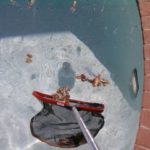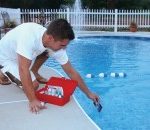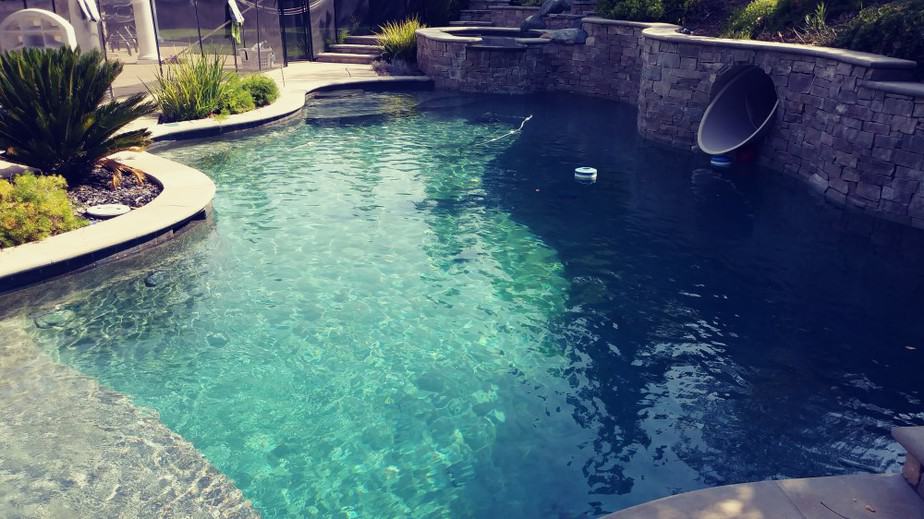Weekly pool maintenance?! Am I crazy? That depends…Do you, or your kids, like swimming in a clean and clear swimming pool? Then, yes, you need to address pool maintenance on a weekly basis. If not, then your pool very well may turn green on you. If it already has, check out our post on getting your pool back from the brink of swampland.
Pool Maintenance doesn’t have to be time-consuming. The average in-ground backyard pool can be serviced within about fifteen minutes. When maintenance is being done regularly it shouldn’t take any longer than 15-20 minutes by following a 3-step process to make weekly maintenance of your pool simple
- Checking and balancing pool chemicals
- Cleaning the pool
- Check and clean the pool equipment
Weekly Pool Maintenance / Pool Cleaning
The first, and probably most obvious, item to address is the pool vessel itself. In other words, the debris that is in the pool. This is broken down into two smaller categories. Debris removal and surface maintenance.

Leaves, grass, and other organic debris should be removed from the pool as soon as possible. If left in the pool, organic matter will break-down and release algae causing phosphates. Most floating debris will find it’s way to the skimmers. The rest of the debris should be raked, or netted, from the surface and then scooped from down below. For medium to large debris, a typical pool net will work fine. There really is no science to this step…if you see debris, chase it down with the net until it has all been collected and removed from the pool.
Finer debris is best removed using a vacuum hose and vacuum head like this high-quality vacuum head from FirbroPool. This is not a hard process, but always use caution when working around a pool’s suction. There are different schools of thought as to whether a pool needs to be vacuumed weekly or not. It’s not absolutely necessary as long as the bigger stuff gets netted out first. There is definitely a difference when it’s done though.
Next, the pool walls and floor needs to be brushed down using a quality brush. Brush in the direction of the main drain or skimmers so the suction of the pool catches resulting debris or dust.
This first step of weekly pool maintenance takes the longest, but still should really only take about 10-minutes. It’s the most labor-intensive part, so everything else should be pretty simple.
Check Pool Equipment Each Week
Every pool will have the same basic equipment components. A pool pump, and pool filter. There are additional items that can be serviced like; chlorinator, heater, and valves, but we will leave those specifics for another time. Also, if you vacuumed the pool, some of these points will need to be covered in conjunction with that step. As a general rule, the pump should be off for this part.
What I like to do is follow the path of the water and check for each service point. The first entry point is the skimmer basket, and/or leaf catch canister if the pool is equipped with a suction-side automatic pool sweep. The catch baskets at this suction point should be emptied and replaced. As we follow the path of the water, the next service point will be the pool pump basket. Remove the basket and empty it. Before replacing the basket, make sure the pot is full of water and then replace the lid.
Now following the water path, you will encounter all the other equipment, including the filter. The filter should only need maintenance every few months, so moving on. The last thing to check for is the catch bag on the pressure side automatic pool sweep, if so equipped. Tag the pool sweep out of the water, remove the bag and empty it, and then replace the bag and put the sweep back in the water.
How to Check and Balance Pool Chemicals

The last and most important thing to address is the pool chemical balance. This won’t be a deep-dive into pool chemistry, but we will touch on what should be done each week. Check out our other posts that will give more detailed pool chemical information. ALWAYS check/test the water before adding ANY chemicals to it.
The weekly test parameters should be;
- Chlorine
- pH
- Alkalinity
Total Alkalinity is the primary test and should fall within the 80-150ppm range. If it’s low, use Sodium Bicarbonate to bring it up slowly. If it’s high, liquid or granular acid can be used to bring it down.
While similar to total alkalinity, pH should also be checked. The perfect range is 7.4-7.6 pH. If the Alkalinity is within range, but the pH is high, use liquid or granular acid to bring it down slowly. If the pH is low use soda ash to bring it up.
Once the pH and total alkalinity are squared away, move onto chlorine. The optimal chlorine range is 3.0 – 5.0ppm. Many homeowners use chlorine tablets and end up over chlorinating the pool. When Chlorine is within the 5.0ppm range or higher, don’t add more chlorine, it will naturally fall over time. If chlorine is over 10.0ppm a neutralizer should be used before any bathers enter the pool. If you have access, liquid chlorine gives you more control and then use tablets or solid chlorine as a supplement.
Weekly Pool Maintenance
During the swim season, weekly maintenance will keep your pool in tip-top shape. It will also keep the swimmers safe from under, or over, adding chemicals. There are other maintenance items, but these are the three that will keep you going all summer long.
Check out the next article to see where pool algae come from and how to manage it.
Recent Posts
The Origin of Green Algae in Swimming Pools: Unveiling the Culprit
Swimming pools are synonymous with relaxation, fun, and refreshing dips during hot summer days. However, the appearance of green algae can turn this enjoyable experience into a frustrating one. Green...
At the heart of every pool is a filter pump that needs to be run every day for a specified length of time. Rather than try to remember to turn a pool pump on and off every day, pool builders and...


